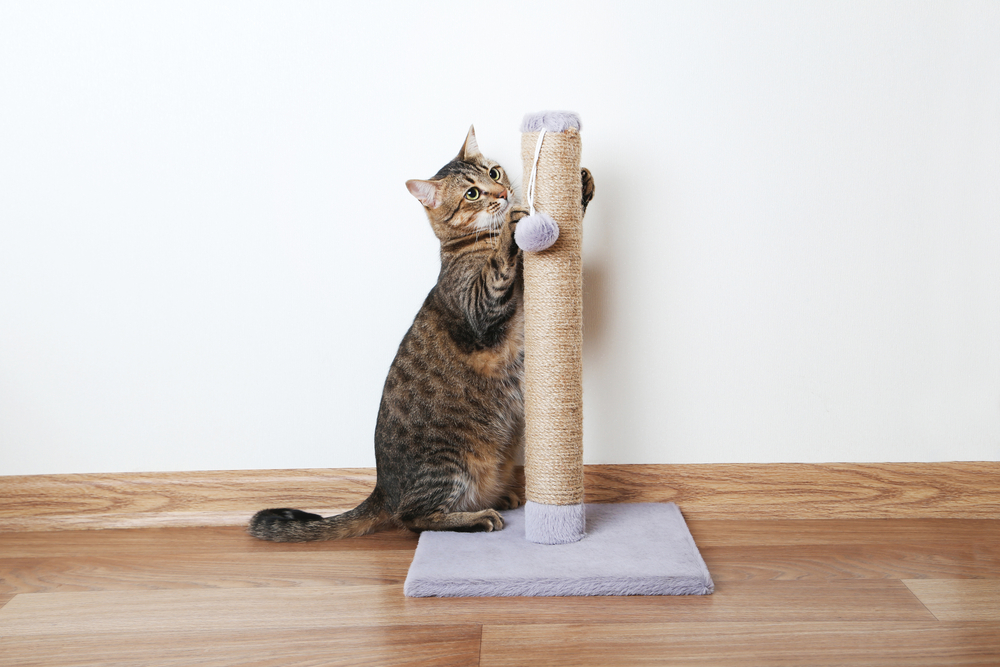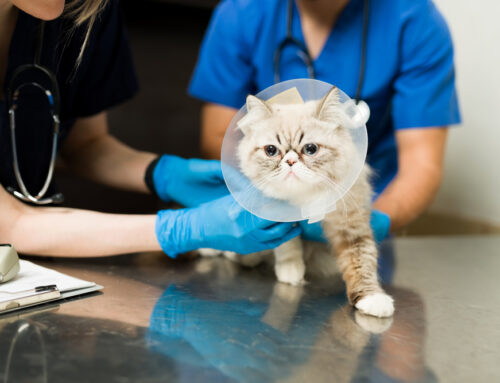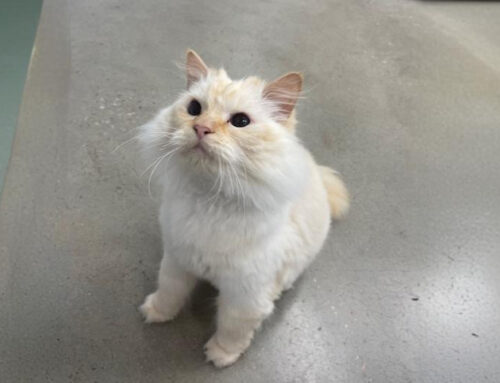Cats have a need—no, not a need for speed—a need to scratch. However, when your cat shreds your upholstery and drapes, you likely detest their instinctual behavior, no matter how normal and necessary. Cats scratch for many reasons, and all of them are essential to their physical and mental wellbeing. If you’re itching to put an end to your cat’s destructive scratching, provide them with appropriate places to practice this essential behavior, rather than exploring ways to curbing their scratching altogether. Our Stack Veterinary Hospital team explains why scratching is important for your cat’s mental health and how you can provide them with an appropriate scratching place that makes you both happy. Scratching supports your cat’s wellbeing in four essential ways.
#1: Cats scratch to maintain their nails
Your cat’s claws grow in layers, and scratching with their front claws—dragging them downward either on a horizontal or vertical surface (i.e., stropping)—helps remove their claws’ worn outer layer to expose the new growth underneath. In addition, scratching keeps your cat’s claws sharp, healthy, and at an optimal length, so they can move comfortably without long, damaged nails snagging on carpeting and furniture.
Tip: Keep your cat’s nails trimmed — Keeping your cat’s nails short reduces their need to scratch. Becoming adept at trimming your cat’s nails will take some practice. If you are unsure how to approach this task, ask your veterinarian to demonstrate an effective strategy. However, if you can master this skill and keep your cat’s claws short, they’re less likely to do damage.
#2: Cats scratch to stay in shape
Exercise supports your cat’s physical health and is also an essential mental health routine. Think of how good you feel when you take a nice, deep stretch, and you can understand why your cat enjoys this practice. Cats stretch their muscles by rising on their hind feet, arching their back, extending their legs and spine, and extruding their claws. This whole-body stretch helps your cat maintain flexibility, grip, and dexterity—through nail extension and retraction—for climbing and hunting.
Tip: Provide physical and mental enrichment for your cat — For cats, enrichment allows them to express natural behaviors such as hunting and foraging—and especially scratching. Spend time petting, snuggling, and playing with your cat each day, and provide them with perches, hiding places, and puzzle toys that encourage their instinctual behaviors.

#3: Cats scratch to express themselves
Have you ever been so excited about something that you could barely sit still? Like people, cats can experience big emotions such as excitement, anxiety, and frustration. Small changes in your cat’s routine can cause them anxiety, and they may scratch to expend some of the energy that develops in response to these feelings.
Tip: Use feline pheromone spray — Pheromones can reduce your cat’s stress and anxiety, decreasing unwanted behaviors such as inappropriate scratching. To deter scratching, apply pheromone spray to the area or object where your cat scratches inappropriately, or use a room diffuser.
#4: Cats scratch to set boundaries
Scratching is a form of feline territorial communication. A cat’s paws have scent glands, and when they scratch something, they apply their scent and visual markers or messages, communicating with other cats and claiming the territory.
Tip: Place scratching posts throughout your house — By placing scratching posts in strategic places throughout your house, you ensure your cat has appropriate outlets for exercising their natural scratching instinct. When choosing the right scratching post for your cat, consider the following factors:
- Placement — Cats typically scratch to claim their territory around sleeping areas and room entrances. By positioning scratching posts in these areas, and near your cat’s food and water bowls, and litter box, you invite your feline friend to stretch and mark their territory while deterring them from inappropriately scratching your furniture.
- Position — Offer your cat vertical and horizontal scratching posts to enable them to stretch different muscles and provide alternative entertainment options. Ensure the scratching posts are long or tall enough for your cat to stretch fully for maximum enjoyment.
- Surface texture — Most cats prefer scratching posts covered in rough material they can shred, such as sisal, carpet, and cardboard. You can determine your cat’s scratching post surface texture preferences by providing them with a variety of types. The scratching post they use the most is likely the type they prefer
- Scratching attractant — Encourage appropriate scratching by applying a cat attractant to the post. When applied to a scratching post, these products tempt your cat to scratch there.
Do not declaw your cat
Some pet owners believe that declawing their cat is a harmless solution for unwanted destructive scratching. However, this could not be further from the truth. Declawing can cause your cat long-term pain and lasting health problems, and can also lead to new behavioral problems. By encouraging appropriate scratching, you can support your cat’s instinctive need to scratch—without sacrificing your furniture
If your cat is destroying your furniture by scratching it to shreds, contact our Stack Veterinary Hospital team. We can determine the cause for your cat’s inappropriate scratching and create an individualized plan to redirect their behavior.







Leave A Comment